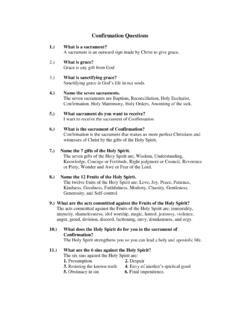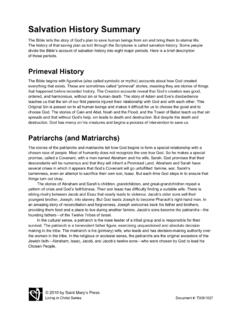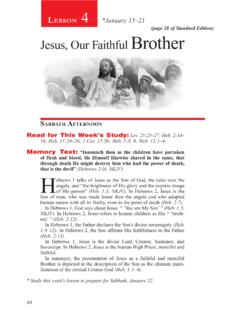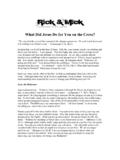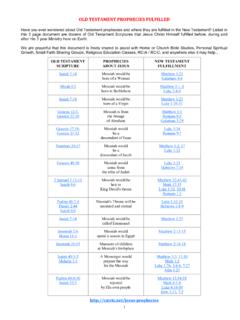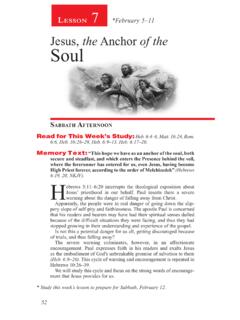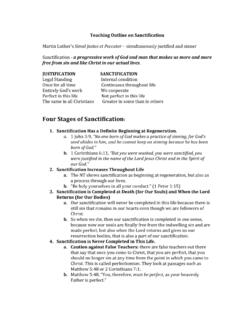Transcription of The Feasts of Israel
1 PassoverPassover, in Hebrew, Pesach (pronounced Pay sakh), is the first and probably best known feast. It comes in the spring, in the Jewish month of Nisan, also called Aviv. Passover commemorates the redemption of the Israelites from Egyptian slavery. Even today, Jewish people have a celebratory meal and liturgy called a Seder (pronounced Say dur) remembering how the blood of the Passover lamb was sprinkled on the crosspiece and sideposts of the door so that the Angel of Death would pass over. John the Baptist pointed to jesus as the Lamb of God. His sacrifice can set us free from the sin that holds us captive (John 1:29). The meal that many know as the Last Supper was actually a Passover celebration. jesus used the holiday as an occasion to picture the sacrifice He was about to make and to provide a way to remember it.
2 To this day, followers of jesus who take communion are hearkening back to jesus words at Passover. The Feast of Unleavened BreadThe Feast of Unleavened Bread begins the day after Passover and lasts for seven days. As it s so closely related to Passover, the names of the two holidays are often interchanged. During Passover and the Feast of Unleavened Bread, the Jewish people remove all leaven from their homes and eat unleavened bread, or matzah. Leaven in Scripture is sometimes a symbol for sin because of the way it spreads, perpetuates itself, and puffs things up. Because of jesus , we can be released from the self-perpetuating sin cycle. For those who know jesus , matzah graphically portrays His pure and sinless nature. The matzah is pierced, even as jesus was pierced by the nails in His hands and feet and the Roman spear in His side; and it is striped in the baking process, reminding us that Isaiah said, He was pierced for our transgressions; he was crushed for our iniquities.
3 And with his wounds we are healed (Isaiah 53:5).The Feast of FirstfruitsThe Feast of Firstfruits, in Hebrew, Hag HaBikkurim (Hag pronounced with a ch sound as in Bach: Chag ha bik kur reem), is celebrated the day after the first day of the Feast of Unleavened Bread. In Bible times, it was a feast of thanksgiving for the barley harvest, the first grain of the season. The first harvest is viewed as a promise of the larger harvest to come. It is significant that jesus rose from the dead on this holiday. Just as the barley harvest was the promise of more to come, He is our firstfruits, the promise of resurrection and eternal life for those who trust Him (1 Corinthians 15:20).The Feast of WeeksThe Feast of Weeks, in Hebrew, Shavuot (pronounced Shah voo oat), is also known by the Greek word Pentecost because it comes 50 days after the Passover Sabbath.
4 Shavuot was also a harvest festival to thank God for the wheat harvest. According to Jewish tradition, it is also the day that Moses received the law on Mount Sinai. The first Shavuot/Pentecost after the death and resurrection of jesus is regarded The annual Feasts of Israel offer great insights into the Jewish roots of the Christian faith as they unfold God s plan of redemption throughout the ages. Leviticus 23 lists these seven Feasts in the order of their seasonal observance: Passover, Unleavened Bread, Firstfruits, Weeks, Trumpets, Day of Atonement, and Feasts of IsraelEach holiday has a seasonal aspect a memorial aspect celebrating God s faithfulness to the Jewish people a prophetic aspect(continued on page 2)by Christians as the birthday of the church.
5 In Bible times, the priests offered two loaves of bread made from newly harvested grain. For believers, this can symbolize God s people, both Jews and Gentiles, made one in the Messiah, jesus . The long gap before the next feast might be seen as our present age, waiting for the return of our Redeemer, Messiah jesus . The Feast of TrumpetsThe Feast of Trumpets, in Hebrew, Yom Teruah (pronounced Yome Teh roo ah), comes in autumn, on Tishrei , the seventh month of the Jewish calendar. Today, it is commonly called Rosh Hashanah, and is known as the Jewish New Year, marking the beginning of the civil year. God commanded the blowing of trumpets on this day to call the congregation of Israel together for a very solemn assembly. According to Jewish teachings, Rosh Hashanah is the beginning of 10 days of judgment when the righteous are written into the Book of Life, the wicked are condemned, and those who are not wholly righteous or wholly wicked are given 10 days to repent and thus escape judgment.
6 We who are written in the Lamb s Book of Life do not fear judgment, but draw near to God with confidence (Hebrews 4:14 16).The Day of AtonementThe Day of Atonement, in Hebrew,Yom Kippur (Yome kee poor), is the most solemn day of the Jewish year. It was the only time in Bible days when a person, specifically the high priest, could enter the Holy of Holies. An elaborate ritual that required ceremonial purification (special washing and clothing), as well as sacrifices made according to very detailed prescriptions, made it possible for the priest to ask forgiveness, first for his own sin, and then for the sins of the people. But there is no longer a Temple and therefore, no animal sacrifices. Yom Kippur has become a time of fasting and prayer.
7 People hope that repentance will suffice for forgiveness of sins, but they have no assurance that God has heard and forgiven them, for the Scriptures teach in Leviticus 17:11 that atonement is in the blood. When Christ offered His own blood as our atonement, or covering, the veil of the Temple was torn in two, signifying that He had opened the way into the Holy of Holies. The Feast of TabernaclesThe Feast of Tabernacles (or Booths) is the seventhand final annual feast. In Hebrew, it is Sukkot (Soo kote). In Bible days, this was the final fall harvest festival, a time of ingathering at Jerusalem. The Jewish people built booth-like structures and lived in them during this feast as a reminder of the temporary dwellings that were a way of life for our ancestors during the 40 years of wilderness wanderings.
8 Today, many Jewish people still build open-roofed, three-sided huts and decorate them with tree boughs and autumn fruits for this festival. Everyone in Israel who was able, came up to Jerusalem for this harvest festival every year. The Temple worship for the holiday included the ritual pouring of water from the pool of Siloam, symbolic of the prayers for the winter rains. It was at this time that jesus cried out, If anyone thirsts, let him come to me and drink (John 7:37).John wrote in Revelation 21:3: Behold, the dwelling place of God is with man. He will dwell with them, and they will be his people, and God himself will be with them as their God. The SabbathThere is one more holy time, but it is weekly, not annually.
9 The Sabbath, which falls every seventh day, was to be a sign to Israel that you may know that I, the Lord, sanctifies you (Exodus 31:13). This national day of rest reminds the Jewish people that God rested after creation (Exodus 20:11), and rest is therefore holy. Also the exodus enabled Israel to enjoy rest following generations of slavery (Deuteronomy 5:15). As believers in jesus , we look forward to eternal rest. We will no longer struggle with sin, but in God s presence, we will find never-ending refreshment and joy. The future fulfillment of the Sabbath, like the future fulfillment of the Feast of Tabernacles, will transform the remembrance of what God has done into the fullness of His promises, kept perfectly throughout see more articles on these Feasts , go SEASONORIGINAL SIGNIFICANCE FOR ISRAELPROPHETIC SIGNIFICANCE BIBLICAL PROMISEFULFILLMENTP esachPassover/ Unleavened BreadSpringThe first of three pilgrimage festivals held in JerusalemRedemption from bondage in Egypt Purging of all leaven (symbol of sin)
10 Believers in Christ redeemed from bondage of sinAll believers in Christ cleansed from sin and empowered to walk in newness of lifeYou were ransomed from the futile ways inherited from your forefathers, not with perishable things such as silver or gold, but with the precious blood of Christ, like that of a lamb without blemish or spot. (1 Peter 1:18 19)Cleanse out the old leaven that you may be a new lump.. For Christ, our Passover lamb, has been sacrificed. (1 Corinthians 5:7)[God] made him to be sin who knew no sin, so that in him we might become the righteousness of God. (2 Corinthians 5:21) Redemption through the crucifixionHag HaBikkurim FirstfruitsSpring First of grain harvestThanksgiving for firstfruits The promise of the harvest to come (first of the grain presented to God)Christ, the first to rise from the dead the promise of resurrection and eternal life for all who believe in Him But now Christ is risen from the dead.


